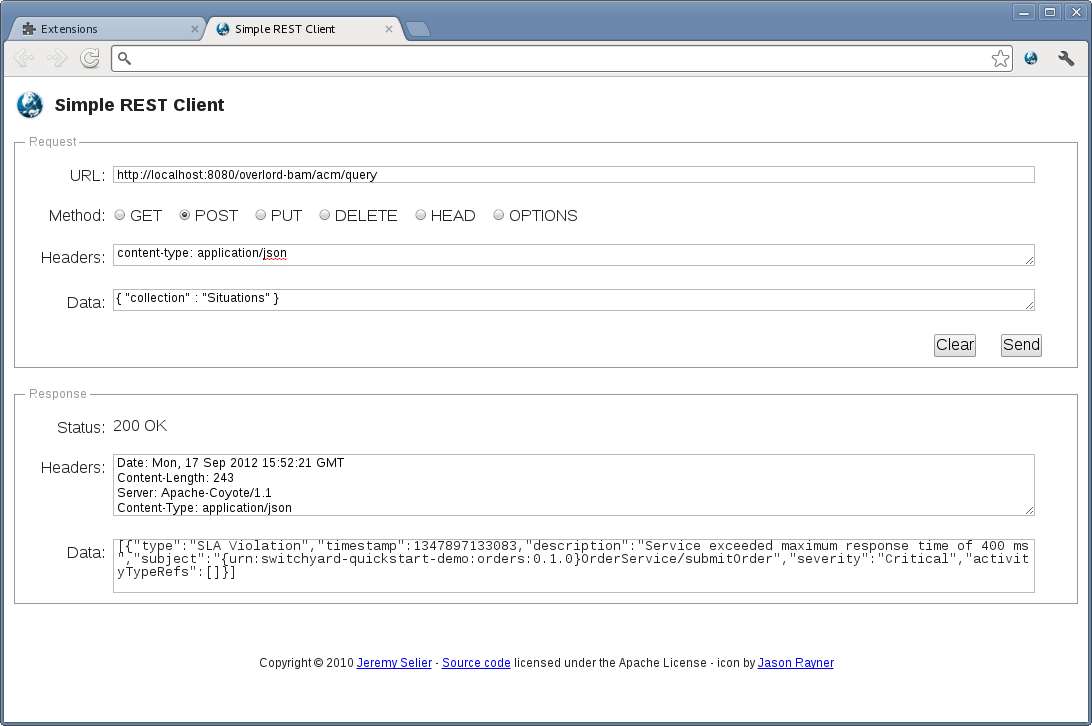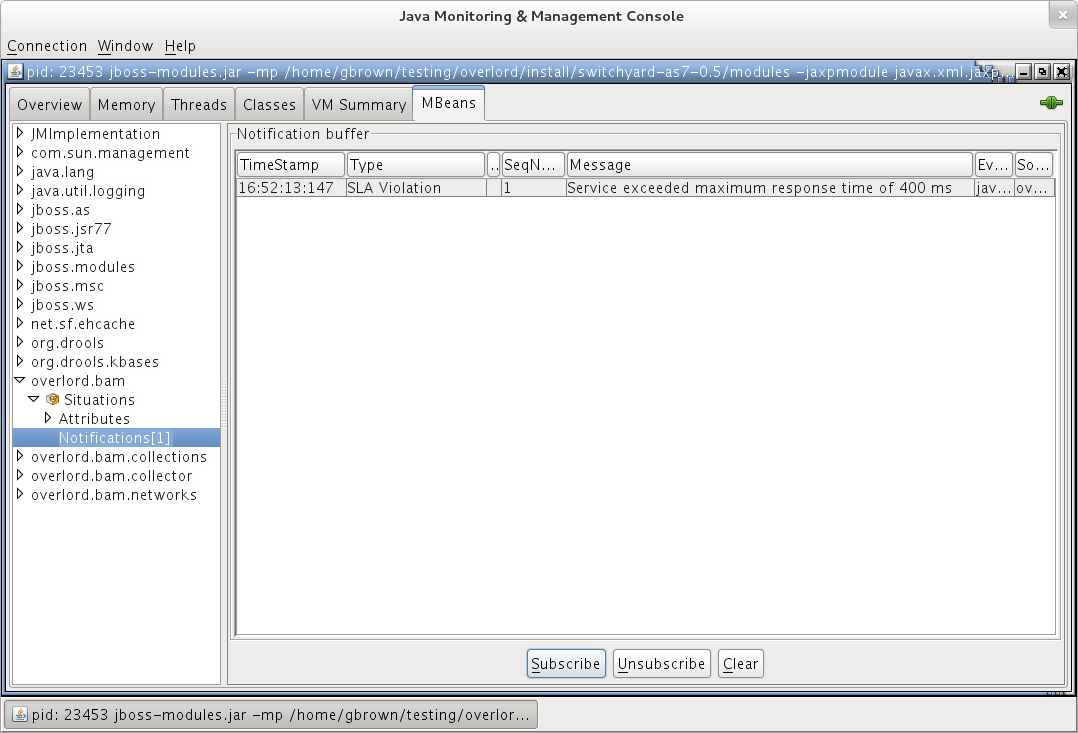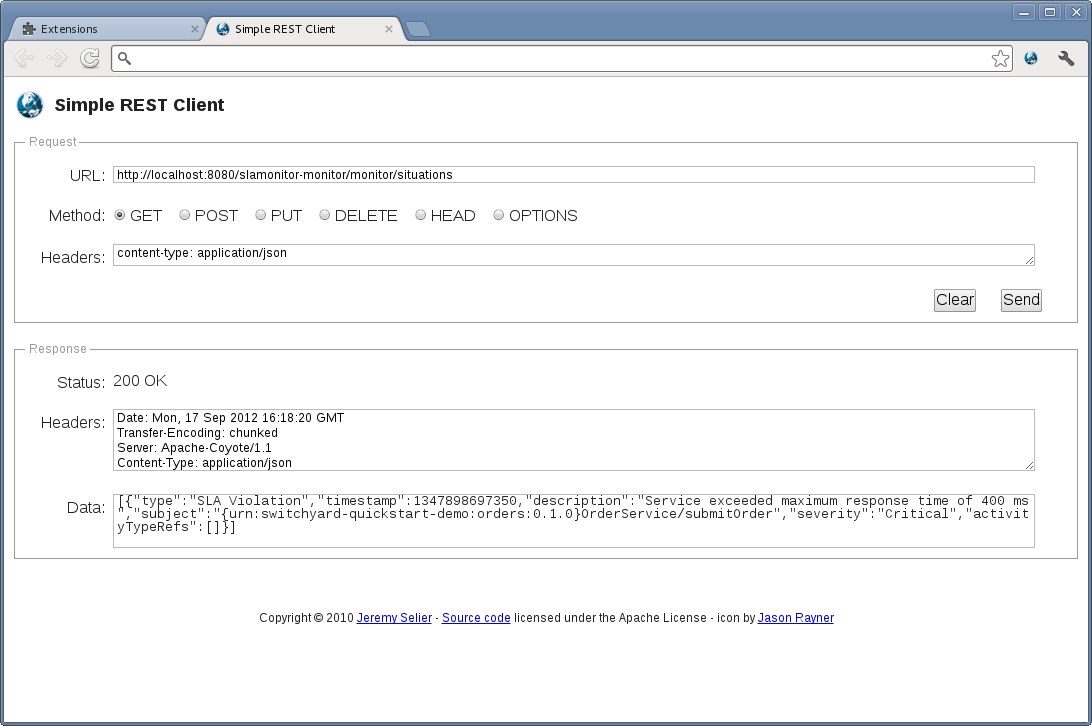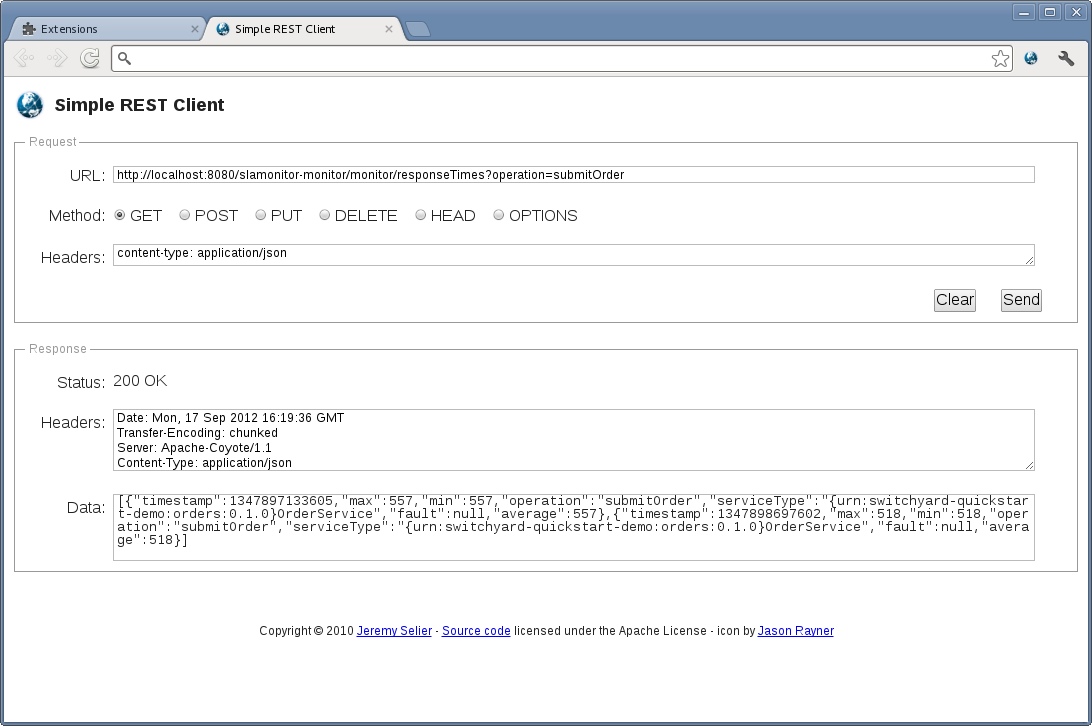This guide provides an introduction to the quickstarts that are distributed with the Overlord Runtime Governance project.
This example, located in the samples/policy folder, demonstrates one approach that can be used to provide "policy enforcement". This example makes uses of the example Switchyard application located in the samples/ordermgmt folder.
This example shows how a business policy can be implemented in a synchronous (or inline) manner, where the decision is taken immediate, and can therefore be used to influence the current business transaction. The benefit of this approach is that it can ensure only valid transactions are permitted, as decisions can be immediately enforced, however the disadvantage is the potential performance impact this may have on the business transaction.
This example will show how:
- activity event analysis, using the Activity Validator mechanism, to implement the business policy
The runtime governance infrastructure analyses the activity events generated by an executing business transaction using one or more Activity Validators. By default, Activity Validators are not invoked from within the SwitchYard environment. The specific SwitchYard applications need to be configured to include an auditor that will invoke the validation. In the Order Management quickstart, this is achieved using the class org.switchyard.quickstarts.demos.orders.auditors.ExchangeValidator. This class is derived from an abstract base class that provides most of the required functionality for converting an Exchange message into an activity event. For example,
@Audit({Processors.TRANSFORMATION})
@Named("ExchangeValidator")
public class ExchangeValidator extends AbstractExchangeValidator implements Auditor {
public void afterCall(Processors processor, org.apache.camel.Exchange exch) {
ExchangePhase phase=exch.getProperty("org.switchyard.bus.camel.phase", ExchangePhase.class);
if (phase == ExchangePhase.OUT) {
handleExchange(exch, phase);
}
}
public void beforeCall(Processors processor, org.apache.camel.Exchange exch) {
ExchangePhase phase=exch.getProperty("org.switchyard.bus.camel.phase", ExchangePhase.class);
if (phase == ExchangePhase.IN) {
handleExchange(exch, phase);
}
}
}
The following Activity Validator configuration is deployed in the environment responsible for execution the business transaction, and gets registered with the Activity Collector mechanism:
[{
"name" : "RestrictUsage",
"version" : "1",
"predicate" : {
"@class" : "org.overlord.rtgov.ep.mvel.MVELPredicate",
"expression" : "event instanceof org.overlord.rtgov.activity.model.soa.RequestReceived && event.serviceType == \"{urn:switchyard-quickstart-demo:orders:0.1.0}OrderService\""
},
"eventProcessor" : {
"@class" : "org.overlord.rtgov.ep.mvel.MVELEventProcessor",
"script" : "VerifyLastUsage.mvel",
"services" : {
"CacheManager" : {
"@class" : "org.overlord.rtgov.ep.service.infinispan.InfinispanCacheManager"
}
}
}
}]
This Activity Validator receives activity events generated from the executing environment and applies the optional predicate to determine if they are of interest to the defined event processor. In this case, the predicate is checking for received requests for the OrderService service.
For events that pass this predicate, they are submitted to the business policy, defined using the MVEL script VerifyLastUsage.mvel, which is:
String customer=event.properties.get("customer");
if (customer == null) {
return;
}
cm = epc.getService("CacheManager");
// Attempt to lock the entry
if (!cm.lock("Principals", customer)) {
epc.handle(new java.lang.RuntimeException("Unable to lock entry for principal '"+customer+"'"));
return;
}
// Access the cache of principals
principals = cm.getCache("Principals");
principal = principals.get(customer);
if (principal == null) {
principal = new java.util.HashMap();
}
java.util.Date current=principal.get(event.serviceType+"-lastaccess");
java.util.Date now=new java.util.Date();
if (current != null && (now.getTime()-current.getTime()) < 2000) {
epc.handle(new java.lang.RuntimeException("Customer '"+customer+"' cannot perform more than one request every 2 seconds"));
return;
}
principal.put(event.serviceType+"-lastaccess", now);
principals.put(customer, principal);
epc.logDebug("Updated principal '"+customer+"': "+principals.get(customer));
This script uses the CacheManager service, configured within the EventProcessor component, to obtain a cache called "Principals". This cache is used to store information about Principals as a map of properties. The implementation uses Infinispan, to enable the cache to be shared between other applications, as well as in a distributed/cluster environment (based on the infinispan configuration).
If a policy violation is detected, the script returns an exception using the handle() method on the EventProcessor context. This results in the exception being thrown back to the execution environment, interrupting the execution of the business transaction.
To install the example, simply set the JBOSS_HOME environment variable to the location of your switchyard installation (download from the latest switchyard-as7 zip from [https://www.jboss.org/switchyard/downloads]).
Then open a command window, set the current working directory to the ${rtgov}/samples/ordermgmt folder, and run:
mvn clean install
Then change to the ${rtgov}/samples/policy/sync folder and run the same command again.
To run the example, the first step is to start the Switchyard server using the following command from the bin folder:
./standalone.sh --server-config=standalone-full.xml
Once the server has fully started, then send the following message (using SOAP-UI or an equivalent SOAP client) twice in less than 2 seconds to: http://localhost:8080/demo-orders/OrderService
<?xml version="1.0" encoding="UTF-8"?>
<soap:Envelope xmlns:soap="http://schemas.xmlsoap.org/soap/envelope/">
<soap:Body>
<orders:submitOrder xmlns:orders="urn:switchyard-quickstart-demo:orders:1.0">
<order>
<orderId>PO-19838-XYZ</orderId>
<itemId>BUTTER</itemId>
<quantity>100</quantity>
<customer>Fred</customer>
</order>
</orders:submitOrder>
</soap:Body>
</soap:Envelope>
If the two requests are received within two seconds of each other, this will result in the following response:
<soap:Envelope xmlns:soap="http://schemas.xmlsoap.org/soap/envelope/">
<soap:Body>
<soap:Fault>
<faultcode>soap:Server</faultcode>
<faultstring>org.switchyard.exception.SwitchYardException: Customer 'Fred' cannot perform more than one request every 2 seconds</faultstring>
</soap:Fault>
</soap:Body>
</soap:Envelope>
This example shows how a business policy can be implemented in an asynchronous (or out-of-band) manner, where the decision is taken after the fact, and can therefore only be used to influence future business transactions. The benefit of this approach is that the decision making process does not have to occur immediately and therefore avoids potentially impacting the performance of the business transaction. The disadvantage is that it does not permit any decision that is made to be enforced immediately.
This example will show how:
- activity event analysis, using the Event Processor Network mechanism, can be used to implement business policies
- results from the business policies can be cached for reference by other applications
- platform specific interceptors can reference the results to impact the behavior of the business transaction (e.g. prevent suspended customers purchasing further items)
There are three components that comprise the policy within this example.
The runtime governance infrastructure analyses the activity events generated by an executing business transaction using one or more Event Processor Networks (or EPN).
A standard EPN is deployed within the infrastructure to isolate the SOA events (e.g. request/responses being sent or received). This quickstart deploys another EPN:
{
"name" : "AssessCreditPolicyEPN",
"version" : "1",
"subscriptions" : [ {
"nodeName" : "AssessCredit",
"subject" : "SOAEvents"
} ],
"nodes" : [
{
"name" : "AssessCredit",
"sourceNodes" : [ ],
"destinationSubjects" : [ ],
"maxRetries" : 3,
"retryInterval" : 0,
"predicate" : {
"@class" : "org.overlord.rtgov.ep.mvel.MVELPredicate",
"expression" : "event.serviceProvider && !event.request && event.serviceType == \"{urn:switchyard-quickstart-demo:orders:0.1.0}OrderService\""
},
"eventProcessor" : {
"@class" : "org.overlord.rtgov.ep.mvel.MVELEventProcessor",
"script" : "AssessCredit.mvel",
"services" : {
"CacheManager" : {
"@class" : "org.overlord.rtgov.ep.service.infinispan.InfinispanCacheManager"
}
}
}
}
]
}
This EPN subscribes to the published SOA events and applies the predicate which ensures that only events from a service provider interface, that are responses and are associated with the OrderService service, will be processed. Events that pass this predicate are then submitted to the business policy (defined in the MVEL script AssessCredit.mvel), which is:
String customer=event.properties.get("customer");
if (customer == null) {
return;
}
cm = epc.getService("CacheManager");
// Attempt to lock the entry
if (!cm.lock("Principals", customer)) {
epc.handle(new Exception("Unable to lock entry for principal '"+customer+"'"));
return;
}
// Access the cache of principals
principals = cm.getCache("Principals");
principal = principals.get(customer);
if (principal == null) {
principal = new java.util.HashMap();
}
int current=principal.get("exposure");
if (current == null) {
current = 0;
}
if (event.operation == "submitOrder") {
double total=event.properties.get("total");
int newtotal=current+total;
if (newtotal > 150 && current <= 150) {
principal.put("suspended", Boolean.TRUE);
}
principal.put("exposure", newtotal);
} else if (event.operation == "makePayment") {
double amount=event.properties.get("amount");
int newamount=current-amount;
if (newamount <= 150 && current > 150) {
principal.put("suspended", Boolean.FALSE);
}
principal.put("exposure", newamount);
}
principals.put(customer, principal);
epc.logDebug("Updated principal '"+customer+"': "+principals.get(customer));
This script uses the CacheManager service, configured within the EPN node, to obtain a cache called "Principals". This cache is used to store information about Principals as a map of properties. The implementation uses Infinispan, to enable the cache to be shared between other applications, as well as in a distributed/cluster environment (based on the infinispan configuration).
As mentioned in the previous section, the results derived from the previous policy are stored in an Infinispan implemented cache called "Principals". To make this information available to runtime governance clients, we use the Active Collection mechanism - more specifically we define an Active Collection that wraps the Infinispan cache.
The configuration of the Active Collection Source is:
[
{
......
},{
"@class" : "org.overlord.rtgov.active.collection.ActiveCollectionSource",
"name" : "Principals",
"type" : "Map",
"visibility" : "Private",
"factory" : {
"@class" : "org.overlord.rtgov.active.collection.infinispan.InfinispanActiveCollectionFactory",
"cache" : "Principals"
}
}
]
The visibility is marked as private to ensure that exposure information regarding customers is not publicly available via the Active Collection REST API.
The enforcement is provided by a specific Switchyard ExchangeHandler implementation (PolicyEnforcer) that is included with the order management application. The main part of this handler is:
public void handleMessage(Exchange exchange) throws HandlerException {
....
if (_principals != null) {
String contentType=null;
for (Property p : exchange.getContext().getProperties(
org.switchyard.Scope.valueOf(exchange.getPhase().toString()))) {
if (p.getName().equals("org.switchyard.contentType")) {
contentType = ((QName)p.getValue()).toString();
}
}
if (exchange.getPhase() == ExchangePhase.IN
&& contentType != null
&& contentType.equals("{urn:switchyard-quickstart-demo:orders:1.0}submitOrder")) {
String customer=getCustomer(exchange);
if (customer != null && _principals.containsKey(customer)) {
java.util.Map<String,java.io.Serializable> props=
(java.util.Map<String,java.io.Serializable>)
_principals.get(customer);
// Check if customer is suspended
if (props.containsKey("suspended")
&& props.get("suspended").equals(Boolean.TRUE)) {
throw new HandlerException("Customer '"+customer
+"' has been suspended");
}
}
}
}
}
The variable _principals refers to an Active Map used to maintain information about the principal (i.e. the customer in this case). This information is updated using the policy rule defined in the previous section.
To install the example, simply set the JBOSS_HOME environment variable to the location of your switchyard installation (download from the latest switchyard-as7 zip from [https://www.jboss.org/switchyard/downloads]).
Then open a command window, set the current working directory to the ${rtgov}/samples/ordermgmt folder, and run:
mvn clean install
Then change to the ${rtgov}/samples/policy/async folder and run the same command again.
To run the example, the first step is to start the Switchyard server using the following command from the bin folder:
./standalone.sh --server-config=standalone-full.xml
Once the server has fully started, then send the following message (using SOAP-UI or an equivalent SOAP client) to: http://localhost:8080/demo-orders/OrderService
<?xml version="1.0" encoding="UTF-8"?>
<soap:Envelope xmlns:soap="http://schemas.xmlsoap.org/soap/envelope/">
<soap:Body>
<orders:submitOrder xmlns:orders="urn:switchyard-quickstart-demo:orders:1.0">
<order>
<orderId>PO-19838-XYZ</orderId>
<itemId>BUTTER</itemId>
<quantity>100</quantity>
<customer>Fred</customer>
</order>
</orders:submitOrder>
</soap:Body>
</soap:Envelope>
This will result in the following response, indicating that the purchase was successful, as well as identifying the total cost of the purchase (i.e. 125).
<SOAP-ENV:Envelope xmlns:SOAP-ENV="http://schemas.xmlsoap.org/soap/envelope/">
<SOAP-ENV:Header/>
<SOAP-ENV:Body>
<orders:submitOrderResponse xmlns:orders="urn:switchyard-quickstart-demo:orders:1.0">
<orderAck>
<orderId>PO-19838-XYZ</orderId>
<accepted>true</accepted>
<status>Order Accepted</status>
<customer>Fred</customer>
<total>125.0</total>
</orderAck>
</orders:submitOrderResponse>
</SOAP-ENV:Body>
</SOAP-ENV:Envelope>
You may recall from the overview above that the threshold if 150, the customer would be suspended. Therefore if the same request is issued again, resulting in another total of 125, then the overall exposure regarding this customer is now 250.
If we then attempt to issue the same request a third time, this time we will receive a SOAP fault from the server. This is due to the fact that the PolicyEnforcer handler has intercepted the request, and detected that the customer is now suspended.
<SOAP-ENV:Envelope xmlns:SOAP-ENV="http://schemas.xmlsoap.org/soap/envelope/">
<SOAP-ENV:Header/>
<SOAP-ENV:Body>
<SOAP-ENV:Fault>
<faultcode>SOAP-ENV:Server</faultcode>
<faultstring>Customer 'Fred' has been suspended</faultstring>
</SOAP-ENV:Fault>
</SOAP-ENV:Body>
</SOAP-ENV:Envelope>
If we now send a "makePayment" request as follows to the same URL:
<soapenv:Envelope xmlns:soapenv="http://schemas.xmlsoap.org/soap/envelope/" xmlns:urn="urn:switchyard-quickstart-demo:orders:1.0">
<soapenv:Header/>
<soapenv:Body>
<urn:makePayment>
<payment>
<customer>Fred</customer>
<amount>200</amount>
</payment>
</urn:makePayment>
</soapenv:Body>
</soapenv:Envelope>
this will result in the customer being unsuspended, as it removes 200 from their current exposure (leaving 50). To confirm this, try sending the "submitOrder" request again.
This quickstart example demonstrates how a policy enforcement mechanism can be provided using a combination of the Runtime Governance infrastructure and platform specific interceptors.
This particular example uses an asynchronous approach to evaluate the business policies, only enforcing the policy based on a summary result from the decision making process. The benefit of this approach is that it can be more efficient, and reduce the performance impact on the business transaction being policed. The disadvantage is that decisions are made after the fact, so leaves a tiny window of opportunity for invalid transactions to be performed.
This example, located in the samples/slamonitor folder, demonstrates an approach to provide "Service Level Agreement" monitoring. This example makes uses of the example Switchyard application located in the samples/ordermgmt folder.
This example will show how:
-
activity event analysis, using the Event Processor Network mechanism, can be used to implement Service Level Agreements
- uses the Complex Event Processing (CEP) based event processor (using Drools Fusion)
-
impending or actual SLA violations can be reported for the attention of end users, via
- JMX notifications
- REST service
- to build a custom application to access the analysis results (see child page)
This example shows a simple Service Level Agreement that checks whether a service response time exceeds expected levels. The CEP rule detects whether a situation of interest has occurred, and if so, creates a org.overlord.rtgov.analytics.Situation object and initializes it with the appropriate description/severity information, before forwarding it back into the EPN. This results in the "Situation" object being published as a notification on the "Situations" subject.
The CEP rule is:
import org.overlord.rtgov.analytics.service.ResponseTime
import org.overlord.rtgov.analytics.Situation
global org.overlord.rtgov.ep.EPContext epc
declare ResponseTime
@role( event )
end
rule "check for SLA violations"
when
$rt : ResponseTime() from entry-point "ServiceResponseTimes"
then
if ($rt.getAverage() > 200) {
epc.logError("\r\n\r\n**** RESPONSE TIME "+$rt.getAverage()+"ms EXCEEDED SLA FOR "+$rt.getServiceType()+" ****\r\n");
Situation situation=new Situation();
situation.setType("SLA Violation");
situation.setSubject($rt.getServiceType()+"/"+$rt.getOperation());
situation.setTimestamp(System.currentTimeMillis());
situation.getProperties().putAll($rt.getProperties());
if ($rt.getRequestId() != null) {
situation.getActivityTypeIds().add($rt.getRequestId());
}
if ($rt.getResponseId() != null) {
situation.getActivityTypeIds().add($rt.getResponseId());
}
situation.getContext().addAll($rt.getContext());
String serviceName=$rt.getServiceType();
if (serviceName.startsWith("{")) {
serviceName = javax.xml.namespace.QName.valueOf(serviceName).getLocalPart();
}
if ($rt.getAverage() > 400) {
situation.setDescription(serviceName+" exceeded maximum response time of 400 ms");
situation.setSeverity(Situation.Severity.Critical);
} else if ($rt.getAverage() > 320) {
situation.setDescription(serviceName+" exceeded response time of 320 ms");
situation.setSeverity(Situation.Severity.High);
} else if ($rt.getAverage() > 260) {
situation.setDescription(serviceName+" exceeded response time of 260 ms");
situation.setSeverity(Situation.Severity.Medium);
} else {
situation.setDescription(serviceName+" exceeded response time of 200 ms");
situation.setSeverity(Situation.Severity.Low);
}
epc.handle(situation);
}
end
The "out of the box" active collection configuration is pre-initialized with a collection for the org.overlord.rtgov.analytics.Situation objects, subscribing to the "Situations" subject from the Event Processor Network. Therefore any detected SLA violations will automatically be stored in this collection (accessible via a RESTful service), and reported to the associated JMX notifier.
To install the example, simply set the JBOSS_HOME environment variable to the location of your switchyard installation (download from the latest switchyard-as7 zip from https://www.jboss.org/switchyard/downloads).
Then open a command window, set the current working directory to the ${rtgov}/samples/ordermgmt folder, and run:
mvn clean install
Then change to the ${rtgov}/samples/slamonitor folder and run the same command again.
To run the example, the first step is to start the Switchyard server using the following command from the bin folder:
./standalone.sh --server-config=standalone-full.xml
Once the server has fully started, then send the following message (using SOAP-UI or an equivalent SOAP client) to: http://localhost:8080/demo-orders/OrderService
<soap:Envelope xmlns:soap="http://schemas.xmlsoap.org/soap/envelope/">
<soap:Body>
<orders:submitOrder xmlns:orders="urn:switchyard-quickstart-demo:orders:1.0">
<order>
<orderId>PO-19838-XYZ</orderId>
<itemId>JAM</itemId>
<quantity>400</quantity>
<customer>Fred</customer>
</order>
</orders:submitOrder>
</soap:Body>
</soap:Envelope>
The itemId of "JAM" causes a delay to be introduced in the service, resulting in a SLA violation being detected. This violation can be viewed using two approaches:
Using a suitable REST client, sent the following POST to: http://localhost:8080/overlord-rtgov/acm/query (using content-type of "application/json")
{
"collection" : "Situations"
}
This will result in the following response:

The Situations active collection source also generates JMX notifications that can be subscribed to using a suitable JMX management application. For example, using JConsole we can view the SLA violation:

As well as having access to the information via REST or JMX, it may also be desirable to have more direct access to the active collection results. This section describes the custom app defined in the ${rtgov}/samples/slamonitor/monitor folder.
The following code shows how the custom application initializes access to the relevant active collections:
@Path("/monitor")
@ApplicationScoped
public class SLAMonitor {
private static final String SERVICE_RESPONSE_TIMES = "ServiceResponseTimes";
private static final String SITUATIONS = "Situations";
private static final Logger LOG=Logger.getLogger(SLAMonitor.class.getName());
private static final String ACM_MANAGER = "java:global/overlord-rtgov/ActiveCollectionManager";
private ActiveCollectionManager _acmManager=null;
private ActiveList _serviceResponseTime=null;
private ActiveList _situations=null;
/**
* This is the default constructor.
*/
public SLAMonitor() {
try {
InitialContext ctx=new InitialContext();
_acmManager = (ActiveCollectionManager)ctx.lookup(ACM_MANAGER);
_serviceResponseTime = (ActiveList)
_acmManager.getActiveCollection(SERVICE_RESPONSE_TIMES);
_situations = (ActiveList)
_acmManager.getActiveCollection(SITUATIONS);
} catch (Exception e) {
LOG.log(Level.SEVERE, "Failed to initialize active collection manager", e);
}
}
Then when the REST request is received (e.g. for SLA violations defined as Situations),
@GET
@Path("/situations")
@Produces("application/json")
public java.util.List<Situation> getSituations() {
java.util.List<Situation> ret=new java.util.ArrayList<Situation>();
for (Object obj : _situations) {
if (obj instanceof Situation) {
ret.add((Situation)obj);
}
}
return (ret);
}
To see the SLA violations, send a REST GET request to: http://localhost:8080/slamonitor-monitor/monitor/situations
This will return the following information:

It is also possible to request the list of response time information from the same custom service, using the URL: http://localhost:8080/slamonitor-monitor/monitor/responseTimes?operation=submitOrder

Caution
If no query parameter is provided, then response times for all operations will be returned.
This quickstart demonstrates how Service Level Agreements can be policed using rules defined in an Event Processor Network, and reporting to end users using the pre-configured "Situations" active collection.
The rule used in this example is simple, detecting whether the response time associated with an operation on a service exceeds a particular level. However more complex temporal rules could be defined to identify the latency between any two points in a business transaction flow.